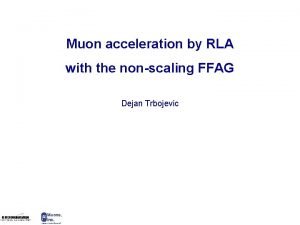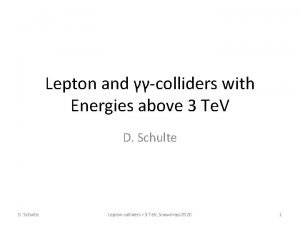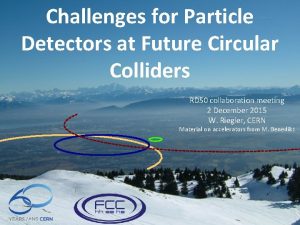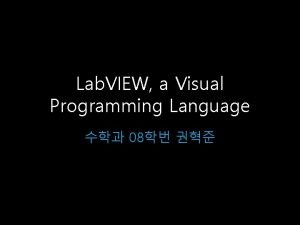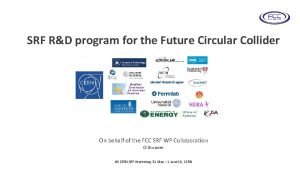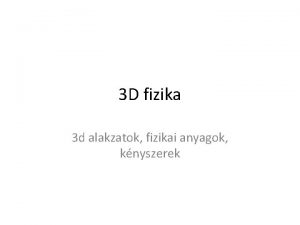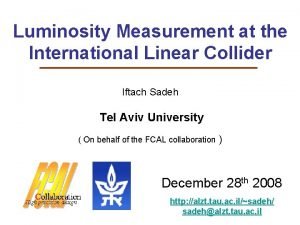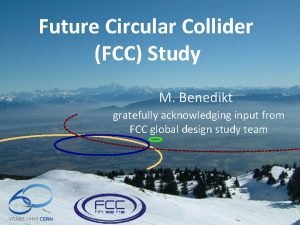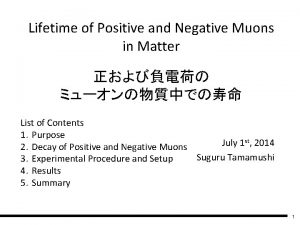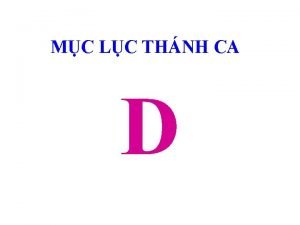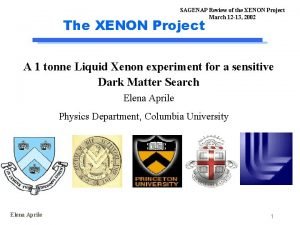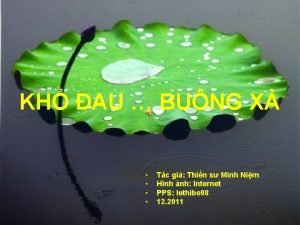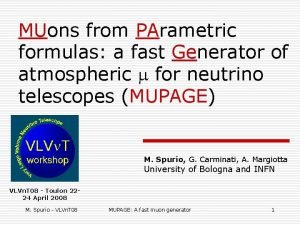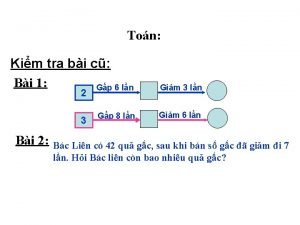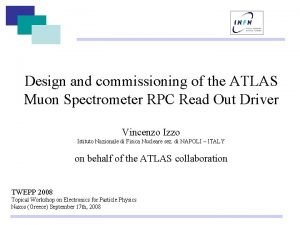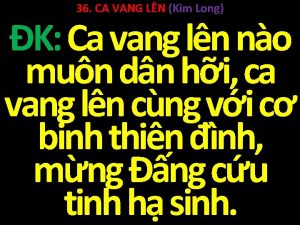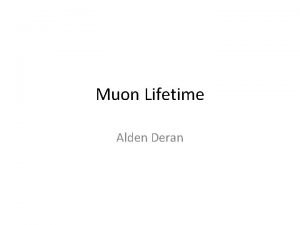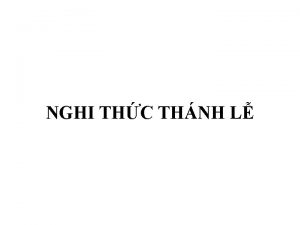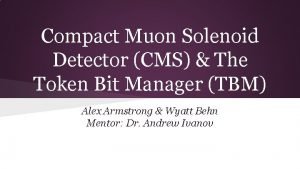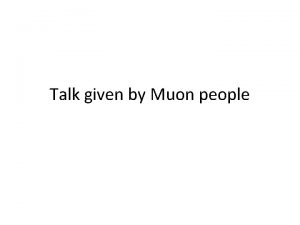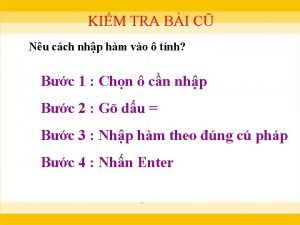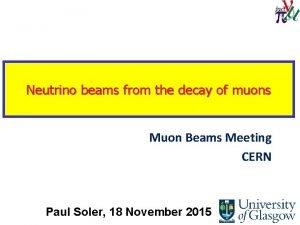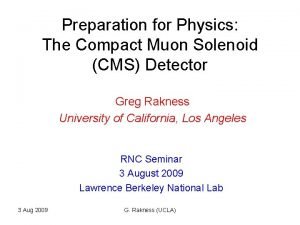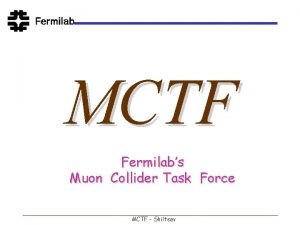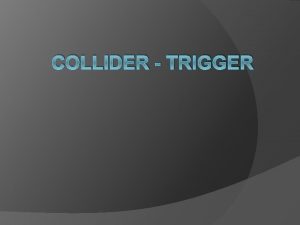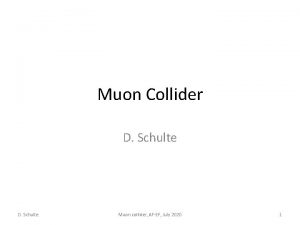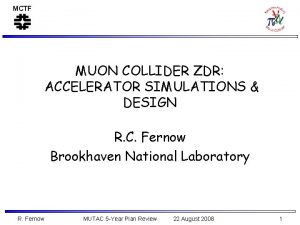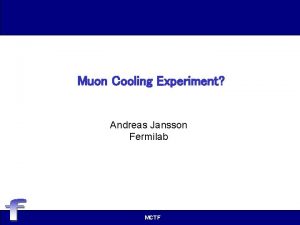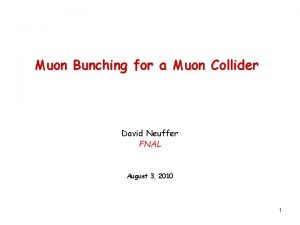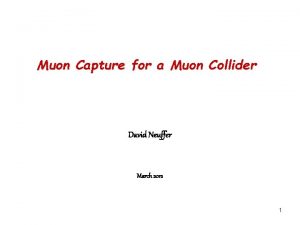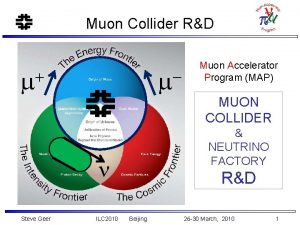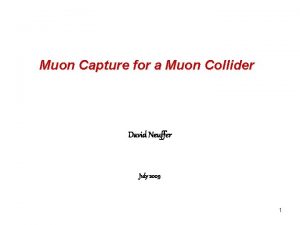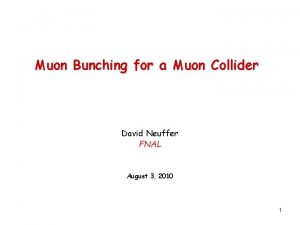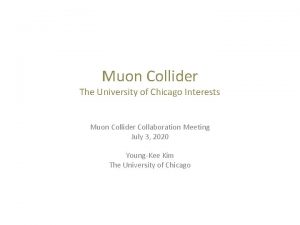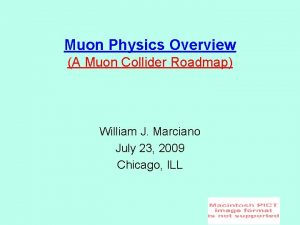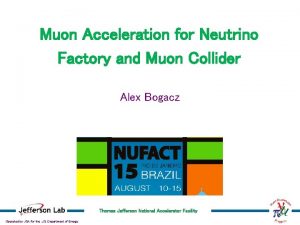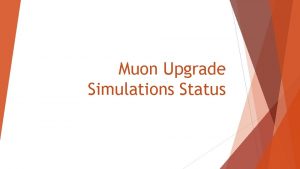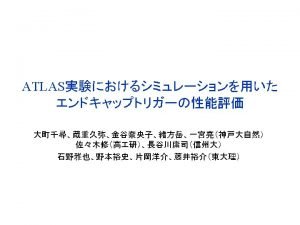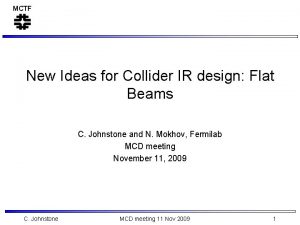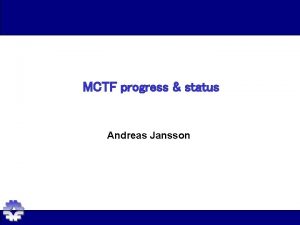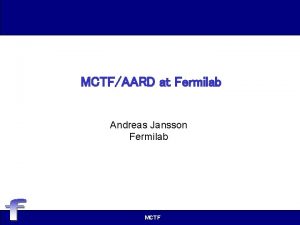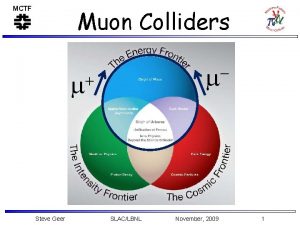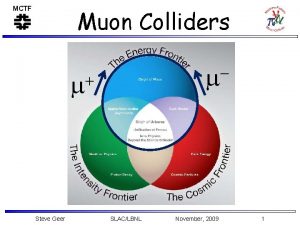MCTF US Muon Collider RD Intiative MCTF Andreas






























- Slides: 30

MCTF US Muon Collider R&D Intiative- MCTF Andreas Jansson (Fermilab)

Outline • Muon Collider Task Force (MCTF) background and organization • Current MCTF R&D Focus • Future plans Also see other talks by eg: Bob Palmer, Rol Johnson, Eliana Gianfelice–Wendt, Mike Lamm… October 22, 2007 2 Andreas Jansson

Why MCTF? Back to the energy frontier 2 Te. V MC Footprint Can do precision physics Compact – fits on Fermilab site October 22, 2007 Andreas Jansson 3

Muon Collider Task Force In July 2006, FNAL Director requested a Task Force aimed at technologies needed for a Muon Collider Strategy: Strengthen accelerator R&D activities hosted at FNAL Focus on critical R&D needing enhanced support Complement ongoing R&D pursued by NFMCC Collaborate closely with NFMCC and Muons Inc. GOAL: Develop designs and technologies so that, within a few years (by ~2012) the community will know whether Muon Colliders are a realistic option for the future, & have a plan & timeline for the remaining R&D October 22, 2007 4 Andreas Jansson

MCTF Scope In October 2006, MCTF submitted initial R&D plan: Focus on Collider Ring design & cooling channel development beyond what is needed for a neutrino factory Proposed to start with 2. 8 M$/year M&S budget, ramp up to 5 M$/yr October 22, 2007 5 Andreas Jansson

MCTF Activities Muon Collider Design and Simulations to establish the required cooling parameters Component Development Helical Magnets HTS High-Field Solenoids Pressurized RF Cavities Beam tests High Pressure Cavity tests 6 D Cooling Channel Experiment October 22, 2007 6 Andreas Jansson

MCTF and NFMCC Co-ordination Mar’ 07: S. Holmes asked that a NFMCC & MCTF Coordinating Committee be formed to coordinate the NFMCC & MCTF Muon Collider activities & ensure the overall R&D is coherent & effective MEMBERS: Alan Bross: NFMCC co-spokesperson, MCTF Str. Grp. Member Steve Geer: MCTF co-leader, NFMCC Exec. Board Member Harold Kirk: NFMCC co-spokesperson Vladimir Shiltsev: MCTF co-leader Mike Zisman: NFMCC Project Manager First meeting March 19 th, 2007. Meets ~1/month, in addition to working weekly meetings of NFMCC and MCTF, annual workshops, etc. Andreas Jansson 7

New Accelerator Physics Center Created June’ 07 AAC meeting, August 6 -8, 2007 - Shiltsev October 22, 2007 Andreas Jansson 8 8

Steering Group Guidance August ’ 07 report: In all scenarios … “R&D for future accelerator options concentrating on a neutrino factory and muon collider should be increased” Group 5 (Colliders beyond LHC and ILC) recommended for Muon Collider R&D in the US: “… a minimum of 20 M$ annually and 100 FTE appropriate skill set …” http: //www. fnal. gov/directorate/Longrange/Steering_Public / October 22, 2007 9 Andreas Jansson

MCTF – the first year Focused on collider parameters, MTA beamline, and preparations for a 6 D cooling experiment Draft annual report available at http: //mctf. fnal. gov In reality, muons got 1. 1 M$ M&S in FY 07 (continuation of existing program, plus MTA proton beamline) FY 08 is first year of real MCTF budget. Guidance is 1. 6 M$/yr. Now considering how to prioritize program. October 22, 2007 10 Andreas Jansson

MCTF Activities Muon Collider Design and Simulations to establish the required cooling parameters Component Development Helical Magnets HTS High-Field Solenoids Pressurized RF Cavities Beam tests High Pressure Cavity tests 6 D Cooling Channel Experiment October 22, 2007 11 Andreas Jansson

High- or Low-Emittance ? High-Emittance Strategy (pursued by MCTF + NFMCC) Package muons into 1 bunch/sign/cycle with number muons limited by beam-beam tune shift. Low-Emittance Strategy (pursued by MCTF + Muons Inc) Lower number muons/bunch with many bunches/ cycle lower transverse emittance at beam-beam tune shift limit. Pros & Cons: Collider ring design for high-emit. case exists … low emit. ring design harder. Additional technologies needed for low emit. , but may yield higher luminosity. In both cases we may be able to use ILC cavities ! October 22, 2007 12 Andreas Jansson

Cooling Channel Simulations exists for all high-emit. cooling channel pieces. Not all matching simulated. Requires “Guggenheim” channel, rebuncher, & HTS solenoids at end. First part of low-emit. cooling channel also simulated. Requires “Helical Magnets”, & high-pressure rf cavities. Last part of channel requires development of concepts (e. g. “Parametric Ionization Cooling”) October 22, 2007 13 Andreas Jansson

Muon Collider Parameters • MCTF intermediate collider parameters based on collider design work • See Eliana’s talk October 22, 2007 Low Emit. High Emit. MCTF 06 s (Te. V) Av. Luminosity (1034/cm 2/s) * Av. Bending field (T) Mean radius (m) No. of IPs Proton Driver Rep Rate (Hz) Beam-beam parameter/IP b* (cm) Bunch length (cm) No. bunches / beam No. muons/bunch (1011) Norm. Trans. Emit. (mm) Energy spread (%) Norm. long. Emit. (m) Total RF voltage (GV) at 800 MHz Muon survival Nm/Nm 0 m+ in collision / proton 8 Ge. V proton beam power Andreas Jansson MCTF 07 1. 5 2. 7 1 1 1. 33 10 361. 4 4 65 6 500 2 13 8. 33 363. 8 2 60 6 500 2 40 0. 052 0. 5 10 1 2. 1 1 0. 35 406. 6 103 c 1 0. 075*** 1. 1 floss 0. 087 1 1 1 20 25 0. 1 0. 07 0. 21** 0. 1 3 2 1 12 13 0. 14 0. 26 103 c 0. 1 1 11. 3 12. 3 0. 2 0. 14 0. 84** 0. 07 0. 01 3. 2 1 0. 15 0. 6 floss 0. 2 0. 03 1. 9 14

RF in magnetic fields • All muon cooling schemes involve RF operating in strong magnetic fields. – Open cell vacuum cavities – Bucking coils to reduce fields at cavities – Magnetically shielded cavities – Pressurized cavities • MCTF focus on HPRF, discussing magnetically shielded cavities Figure from J. Norem October 22, 2007 15 Andreas Jansson

Pressurized RF cavities • Pressurized hydrogen in cavity acts both as absorber and to suppress breakdown. • No degradation of gradient with B-field observed. • Cavity from Muons Inc, tested by Fermilab and Muons Inc staff in MTA. P. Hanlet et al, EPAC’ 06 October 22, 2007 16 Andreas Jansson

MTA beamline • Intense beam will generate lots of ionization – How long do the electrons live (ms or ps)? – Where do the ions go? – Does the cavity still work? • To test pressurized RF with intense beam, need protons to MTA. • Beamline installation ongoing, expect first beam in ~spring 2008. October 22, 2007 17 Andreas Jansson

FY’ 08 HPRF plans • First test using existing (Muons Inc) test cell will tell us a lot. • Depending on outcome, either mitigate problems or build next test cavity October 22, 2007 18 Andreas Jansson

High field solenoids • To minimize the effect of multiple scattering, very strong focusing is needed in the end of the channel. • 50 T solenoid are needed for final cooling. • Need to understand if HTS is a viable option • See Mike Lamm’s talk Plot from E. Barzi October 22, 2007 19 Andreas Jansson

FY’ 08 HTS plans • HTS conductor tests on existing strands • Invest in billets for future conductor tests – Long lead time • Partner with other labs for testing. – Build national HTS collaboration and seek additional funding for conductor development Photo from E. Barzi October 22, 2007 20 Andreas Jansson

Helical Cooling Channel • Ionization cooling is inherently transverse • Can cool longitudinally using wedge absorber in dispersive region. • Can also use path-length difference inside gasfilled magnet. • Possible to arrange fields to get 6 D cooling in continuous absorber • See Rol’s talk Y. Derbenev and R. Johnson, PRST-AB 8, 041002 (2005) October 22, 2007 21 Andreas Jansson

6 D cooling experiment • HCCs promises 6 D cooling factors of 50, 000 in channels of ~200 m, based on simulations. • An experiment is needed to verify these simulations. R. P. Johnson et al, COOL 2005 October 22, 2007 22 Andreas Jansson

MANX • No RF, LHe absorber and tapered fields to match energy loss. • Investigating two possible locations at Fermilab (KTe. V and MTA). • Experiment could be done either with single muons, or muon “beamlets”. • Detector development needed (eg Sci. Fi in LHe) Upstream Matching HCC Downstream Matching K. Yonehara et al, PAC 2007 October 22, 2007 23 Andreas Jansson

HCC magnet design • HCC requires solenoid, helical dipole and helical quadrupole field components. • Can be generated by discrete solenoid coils offset transversely in helical pattern. • Simpler to build, and may allow RF cavities between coils. October 22, 2007 24 V. S. Kashikin et al, ASC 2006 Andreas Jansson

FY’ 08 HCC plans • Build and test a subscale section (4 coils) of helical solenoid magnet – partially funded by Muon Inc SBIR. – Will keep TD magnet people busy for most of ‘ 08 • Define 6 D cooling experiment parameters and start detailed design of the magnet. • Determine best location (muon beamline). October 22, 2007 Figure from V. Kashikin 25 Andreas Jansson

RF in HCC • A ‘real’ HCC needs RF! • Three options studied: 1) RF inside coils • Simulates OK, but cavity frequency restricted to fit radially. Reduces acceptance 2) RF in between coils • Simulations OK for very short cavities. Not sure if practical. 3) Separate HCC and RF sections • Not yet shown to work in simulations. Large time spread in HCC + matching. October 22, 2007 Andreas Jansson 26

Budget crunch • A large component of the proposed $5 M MCTF budget was intended for a 6 D cooling experiment. • With the current budget outlook, may need to rethink – Is a cooling channel test w/o RF the right thing to do? – Can it give timely results with limited funds? – Is there a simpler, more generic test that can be done to validate simulations? October 22, 2007 Andreas Jansson 27

Cooling experiment strategy Assuming HPRF test with beam is successful: Option 1 Option 2 • Build tapered magnet and test cooling properties without RF, using LHe as absorber • Follow up by adding RF section and upgrading to H 2 gas as absorber • Demonstrates “cooling”, but does not develop technology by ~2012 • Design and build a short section of HCC including HPRF, test on bench or in beam. ~2012 • Add more sections for a full-blown 6 D cooling experiment. • Develops technology, but does not demonstrate cooling in HCC by ~2012 October 22, 2007 Andreas Jansson 28

6 D cooling channel strategy cont’d • Pending results from HPRF measurements, pursue both options in parallel RF feed flange – Further simulations of cooling channels with separate HCC and RF sections – Modular design of HCC section with RF windows coils October 22, 2007 Andreas Jansson 29

Summary Aim of MCTF is to boost muon collider R&D in ways that complement and strengthen existing efforts (e. g. NFMCC and Muonc Inc) Goal is to show muon colliders as a viable path by ~2012. Strong moral support (director, steering group etc), but budget not yet up to speed. Need to think hard about how to prioritize program within limited budget. An important milestone will be the HPRF experiment with beam. October 22, 2007 30 Andreas Jansson
 Bnl
Bnl Muon collider
Muon collider Autonomy versus shame
Autonomy versus shame Hadron collider
Hadron collider Fcc collider
Fcc collider Hadron collider
Hadron collider Visual basic programming language
Visual basic programming language Cern future circular collider
Cern future circular collider Unity sphere collider
Unity sphere collider International linear collider
International linear collider Fcc collider
Fcc collider Muonic
Muonic Con xin dâng lên muôn lời suy tôn
Con xin dâng lên muôn lời suy tôn Toshiyuki kamioka
Toshiyuki kamioka Bận lòng chi nắm bắt
Bận lòng chi nắm bắt Cocine
Cocine Muốn tìm số chia
Muốn tìm số chia Muon
Muon ôi giêsu chúa giêsu là vua
ôi giêsu chúa giêsu là vua Ca vang lên
Ca vang lên Muon detector
Muon detector Từ muôn phương ta về đây sánh vai lên đường
Từ muôn phương ta về đây sánh vai lên đường Muon token
Muon token Mênh mông muôn mẫu một màu mưa
Mênh mông muôn mẫu một màu mưa Bài hát đến muôn đời con cảm tạ ơn chúa
Bài hát đến muôn đời con cảm tạ ơn chúa Muon g2
Muon g2 Muốn tính chu vi hình chữ nhật
Muốn tính chu vi hình chữ nhật Muốn xoá một hoặc nhiều cột em thực hiện: *
Muốn xoá một hoặc nhiều cột em thực hiện: * Muốn xóa một hoặc nhiều cột em thực hiện
Muốn xóa một hoặc nhiều cột em thực hiện Muon
Muon Cms compact muon solenoid
Cms compact muon solenoid
